Visualisation of High-Density City Research Evolution, Trends, and Outlook in the 21st Century
Abstract
:1. Introduction
1.1. Literature Review of High-Density Cities
1.1.1. Origin of Modern High-Density Cities
1.1.2. Awareness of High-Density Cities
1.1.3. Exploring the Development Process of High-Density Cities
1.1.4. Review of the Literature on High-Density Cities
1.2. Justification of This Research
1.2.1. Current Status and Dilemmas of High-Density City Research
1.2.2. Aim of This Study
1.2.3. Structure of This Study
2. Materials and Methods
2.1. Data Sources
2.2. Research Methods
3. Results
3.1. Review of Research Progress
3.2. Results by Data Collection
3.2.1. Publication Trends in This Area
3.2.2. Cited Journals
3.2.3. Distribution of Cooperation by Region of Publication
3.2.4. Distribution of Authorship of Articles
3.2.5. Distribution of Research Institute Cooperation
3.3. Research Areas
3.4. Research Hotspots and Research Strategies
3.4.1. Keyword Co-Occurrence Network
3.4.2. Keyword Co-Occurrence Time Zone Analysis
- Start-up period (2001–2006): The high-density city research field began. With the advent of the new century, global initiatives and globalisation have led to an awareness of high-density cities in various regions. However, research was limited by a lack of clarity regarding the definition of high-density cities and a lack of research awareness [70]. During this period, research in this field was relatively limited and slowly developed.
- Development Period (2007–2014): This period was the development phase of high-density city research. As the influence of high-density cities globally expanded and the understanding of high-density cities became clearer, many small relevant topics, such as urban ventilation and carbon dioxide, emerged. Furthermore, there was by a growing awareness of the negative impacts of high-density cities and the need for sustainable cities. With advancements in computer software technology, research scholars have also started innovating research models to better study relevant problems [71]. In this period, the number of topics in high-density city research began to increase, and the degree of connection between the various parts began to strengthen. The research in this period laid the foundation for the current research stage.
- Accelerated period (2015–present): Due to the accelerated globalisation process and expanded knowledge of high-density cities, the high-density city research field has reached an accelerated period. The main causes of this accelerated period are as follows: (1) The impact of high-density cities on the daily activities of people around the world is starting to become greater, which has had significant impacts on people’s living environment [72]; (2) economic activities within cities are still valued [73]; and (3) modernisation has led to people’s right to live and spiritual states being valued [74]. With the conceptual development of the field of urban studies, researchers have started to delve deeper into the fundamentals of high-density cities and to further study aspects of people and their living environments, such as general satisfaction, older adults’ exposure to mental health issues, and thermal comfort, although there are still basic studies, such as those on impact city and land use. This research phase has shown specific and diversified research directions and has linked people and the urban environment while addressing urban resource shortages and environmental issues, including epidemics such as COVID-19, with the ultimate goal of building sustainable cities [75,76]. Although many specific research directions have already been proposed, most studies at this stage have attempted to propose even more directions because the research field has failed to form a complete system. The rapid development and concretisation of various research directions reflect the field’s proximity to cities and their residents, as well as the raising awareness of the field and its significance. Therefore, this acceleration period will continue, and research directions will continue to be specified.
3.4.3. Keyword Clustering Analysis
3.4.4. Research Clustering Timeline
- (1)
- CFD simulation, land use, and mental health showed continuous development trends in recent years. Many subtopics appeared, indicating that this field has been the focus of academic research in recent years. A relatively large amount of research is being conducted under this category of keywords at this stage, which is characteristic of progress. Many other keywords also converged here, indicating increasing cooperation and communication between these fields and other fields, as well as their important role in realising the ultimate sustainable development goals of high-density cities.
- (2)
- Outdoor thermal comfort keywords had an early origin and indicated the recognition of the heat island effect of outdoor spaces in cities. Researchers have gradually recognised ways of mitigating the heat island effect during high-density city development. However, development is somewhat hindered at this stage, and technical and theoretical enhancements are urgently needed.
- (3)
- Frontal area density, land-use regression, and urban planning were found to have early origins. However, their development has been limited to different extents by the policies and technologies of each country, as well as a lack of innovation. However, because of the proven importance of these three keyword areas for the construction of high-density cities, they remain key areas of development at this stage.
- (4)
- The category of person-centred analyses was developed and absorbed by other fields early on, indicating that the other research categories are mostly person-centred ideas.
- (5)
- In general, the development of high-density urban research has mainly been concentrated in recent years, and the research topics have trended from general to specific, indicating the progress of academic understanding in the field of high-density urban research. These changes in development show that the field has been proven to be closely related to people’s daily lives, which is why there are endless potential research directions [77]. As the construction of high-density cities continues, the high-density urban research field will continue to develop and gradually become a key area of research in the current academic era.
3.4.5. Research Trend Analysis
4. Discussion
5. Conclusions
Author Contributions
Funding
Data Availability Statement
Conflicts of Interest
Abbreviation
| Acronym/Abbreviation | Explanation |
| WoSCC | Web of Science Core Collection |
| TOD | Transit-oriented development |
| LSI | Latent Semantic Indexing |
| LLR | Log likelihood ratio test |
| MI | Mutual information |
| CFD | Computational fluid dynamics |
| CNKI | China National Knowledge Infrastructure |
References
- Hepworth, M.E. Planning for the information city: The challenge and response. Urban Stud. 1990, 27, 537–558. [Google Scholar] [CrossRef]
- Zhang, J.; Cenci, J.; Becue, V.; Koutra, S.; Liao, C. Stewardship of Industrial Heritage Protection in Typical Western European and Chinese Regions: Values and Dilemmas. Land 2022, 11, 772. [Google Scholar] [CrossRef]
- Meyers, P.W.; Sivakumar, K.; Nakata, C. Implementation of industrial process innovations: Factors, effects, and marketing implications. J. Prod. Innov. Manag. Int. Publ. Prod. Dev. Manag. Assoc. 1999, 16, 295–311. [Google Scholar] [CrossRef]
- Bai, L.; Xiu, C.; Feng, X.; Liu, D. Influence of urbanization on regional habitat quality: A case study of Changchun City. Habitat Int. 2019, 93, 102042. [Google Scholar] [CrossRef]
- Steffen, W.; Crutzen, P.J.; McNeill, J.R. The Anthropocene: Are humans now overwhelming the great forces of nature. AMBIO J. Hum. Environ. 2007, 36, 614–621. [Google Scholar] [CrossRef]
- Keohane, R.O. After Hegemony: Cooperation and Discord in the World Political Economy; Princeton University Press: Princeton, NJ, USA, 2005. [Google Scholar]
- Hall, P.; Pfeiffer, U. Urban Future 21: A Global Agenda for Twenty-First Century Cities; Routledge: London, UK, 2013. [Google Scholar]
- Scott, A.J. City-regions reconsidered. Environ. Plan. Econ. Space 2019, 51, 554–580. [Google Scholar] [CrossRef]
- Kohout, M.; Kopp, J. Green space ideas and practices in European cities. J. Environ. Plan. Manag. 2020, 63, 2464–2483. [Google Scholar] [CrossRef]
- Zhang, J.; Cenci, J.; Becue, V.; Koutra, S. The Overview of the Conservation and Renewal of the Industrial Belgian Heritage as a Vector for Cultural Regeneration. Information 2021, 12, 27. [Google Scholar] [CrossRef]
- Fang, C. Important progress and future direction of studies on China’s urban agglomerations. J. Geogr. Sci. 2015, 25, 1003–1024. [Google Scholar] [CrossRef] [Green Version]
- Epp, J. Achieving health for all: A framework for health promotion. Health Promot. Int. 1986, 1, 419–428. [Google Scholar] [CrossRef]
- Madlener, R.; Sunak, Y. Impacts of urbanization on urban structures and energy demand: What can we learn for urban energy planning and urbanization management? Sustain. Cities Soc. 2011, 1, 45–53. [Google Scholar] [CrossRef]
- Wilbanks, T.J.; Fernandez, S. Climate Change and Infrastructure, Urban Systems, and Vulnerabilities: Technical Report for the US Department of Energy in Support of the National Climate Assessment; Island Press: Leipsic, Germany, 2014. [Google Scholar]
- Miao, P. Public Places in Asia Pacific Cities: Current Issues and Strategies; Springer Science & Business Media: Berlin/Heidelberg, Germany, 2001; Volume 60. [Google Scholar]
- Ng, E. Towards planning and practical understanding of the need for meteorological and climatic information in the design of high-density cities: A case-based study of Hong Kong. Int. J. Climatol. 2012, 32, 582–598. [Google Scholar] [CrossRef]
- Norton, B.A.; Coutts, A.M.; Livesley, S.J.; Harris, R.J.; Hunter, A.M.; Williams, N.S. Planning for cooler cities: A framework to prioritise green infrastructure to mitigate high temperatures in urban landscapes. Landsc. Urban Plan. 2015, 134, 127–138. [Google Scholar] [CrossRef]
- Carter, J.G.; Cavan, G.; Connelly, A.; Guy, S.; Handley, J.; Kazmierczak, A. Climate change and the city: Building capacity for urban adaptation. Prog. Plan. 2015, 95, 1–66. [Google Scholar] [CrossRef]
- Glaeser, E.L.; Ward, B.A. The causes and consequences of land use regulation: Evidence from Greater Boston. J. Urban Econ. 2009, 65, 265–278. [Google Scholar] [CrossRef] [Green Version]
- Cohen, S. Aftereffects of stress on human performance and social behavior: A review of research and theory. Psychol. Bull. 1980, 88, 82. [Google Scholar] [CrossRef] [PubMed]
- Yang, Y.; Ng, S.T.; Xu, F.J.; Skitmore, M. Towards sustainable and resilient high density cities through better integration of infrastructure networks. Sustain. Cities Soc. 2018, 42, 407–422. [Google Scholar] [CrossRef]
- Das, D.; Keetse, M. Assessment of Traffic Congestion in the Central Areas (CBD) of South African Cities: A Case Study of Kimberly City. 2015. Available online: https://repository.up.ac.za/handle/2263/57788 (accessed on 1 December 2022).
- Lamb, G. Police militarisation and the ‘war on crime’in South Africa. J. S. Afr. Stud. 2018, 44, 933–949. [Google Scholar] [CrossRef]
- Sieverts, T. Cities without Cities: An Interpretation of the Zwischenstadt; Routledge: London, UK, 2003. [Google Scholar]
- Pendall, R. Do land-use controls cause sprawl? Environ. Plan. B Plan. Des. 1999, 26, 555–571. [Google Scholar] [CrossRef] [Green Version]
- Lord, S.; Frémond, M.; Bilgin, R.; Gerber, P. Growth modelling and the management of urban sprawl: Questioning the performance of sustainable planning policies. Plan. Theory Pract. 2015, 16, 385–406. [Google Scholar] [CrossRef]
- Tang, H.-T.; Lee, Y.-M. The making of sustainable urban development: A synthesis framework. Sustainability 2016, 8, 492. [Google Scholar] [CrossRef] [Green Version]
- Storper, M. Keys to the City: How Economics, Institutions, Social Interaction, and Politics Shape Development; Princeton University Press: Princeton, NJ, USA, 2013. [Google Scholar]
- Wu, C.; Cenci, J.; Wang, W.; Zhang, J. Resilient City: Characterization, Challenges and Outlooks. Buildings 2022, 12, 516. [Google Scholar] [CrossRef]
- Zhu, Y.; Koutra, S.; Zhang, J. Zero-Carbon Communities: Research Hotspots, Evolution, and Prospects. Buildings 2022, 12, 674. [Google Scholar] [CrossRef]
- Dustdar, S.; Nastić, S.; Šćekić, O. Smart cities. In The Internet of Things, People and Systems; Springer: Berlin/Heidelberg, Germany, 2017. [Google Scholar]
- Herbert, C.W.; Murray, M.J. Building from scratch: New cities, privatized urbanism and the spatial restructuring of Johannesburg after apartheid. Int. J. Urban Reg. Res. 2015, 39, 471–494. [Google Scholar] [CrossRef]
- Meng, L.; Wen, K.-H.; Zeng, Z.; Brewin, R.; Fan, X.; Wu, Q. The impact of street space perception factors on elderly health in high-density cities in Macau—Analysis based on street view images and deep learning technology. Sustainability 2020, 12, 1799. [Google Scholar] [CrossRef] [Green Version]
- Chung, W.K.; Lin, M.; Chau, C.K.; Masullo, M.; Pascale, A.; Leung, T.M.; Xu, M. On the study of the psychological effects of blocked views on dwellers in high dense urban environments. Landsc. Urban Plan. 2022, 221, 104379. [Google Scholar] [CrossRef]
- Ranhagen, U.; Groth, K. The Symbiocity Approach: A Conceptual Framework for Sustainable Urban Development; SKL International: Stockholm, Sweden, 2012. [Google Scholar]
- Bibri, S.E.; Krogstie, J. Generating a vision for smart sustainable cities of the future: A scholarly backcasting approach. Eur. J. Futures Res. 2019, 7, 1–20. [Google Scholar] [CrossRef] [Green Version]
- Zhang, J.; Heng, C.K.; Malone-Lee, L.C.; Hii, D.J.C.; Janssen, P.; Leung, K.S.; Tan, B.K. Evaluating environmental implications of density: A comparative case study on the relationship between density, urban block typology and sky exposure. Autom. Constr. 2012, 22, 90–101. [Google Scholar] [CrossRef]
- Radtke, J. Smart energy systems beyond the age of COVID-19: Towards a new order of monitoring, disciplining and sanctioning energy behavior? Energy Res. Soc. Sci. 2022, 84, 102355. [Google Scholar] [CrossRef]
- Gottlieb, R.; Ng, S. Global Cities: Urban Environments in Los Angeles, Hong Kong, and China; MIT Press: Cambrige, MA, USA, 2017. [Google Scholar]
- Ghimire, H.; Ariya, P.A. E-wastes: Bridging the knowledge gaps in global production budgets, composition, recycling and sustainability implications. Sustain. Chem. 2020, 1, 154–182. [Google Scholar] [CrossRef]
- World Cities Report 2022. Available online: https://unhabitat.org/wcr/ (accessed on 17 January 2023).
- Around 2.5 Billion More People Will Be Living in Cities by 2050, Projects New UN Report. Available online: https://www.un.org/en/desa/around-25-billion-more-people-will-be-living-cities-2050-projects-new-un-report (accessed on 17 January 2023).
- Marshall, R.E.; Farahbakhsh, K. Systems approaches to integrated solid waste management in developing countries. Waste Manag. 2013, 33, 988–1003. [Google Scholar] [CrossRef] [PubMed]
- Pan, W.; Pan, M. Drivers, barriers and strategies for zero carbon buildings in high-rise high-density cities. Energy Build. 2021, 242, 110970. [Google Scholar] [CrossRef]
- Pan, W.; Yang, Y.; Pan, M. Implementing modular integrated construction in high-rise high-density cities: Perspectives in Hong Kong. Build. Res. Inf. 2022, 10, 1–15. [Google Scholar] [CrossRef]
- Hua, J.; Zhang, X.; Ren, C.; Shi, Y.; Lee, T.-C. Spatiotemporal assessment of extreme heat risk for high-density cities: A case study of Hong Kong from 2006 to 2016. Sustain. Cities Soc. 2021, 64, 102507. [Google Scholar] [CrossRef]
- Beatley, T. Biophilic Cities: Integrating Nature into Urban Design and Planning; Island Press: Leipsic, Germany, 2011. [Google Scholar]
- Koschinsky, J.; Scheer, B.C.; Knaap, G.-J.; Brown, A.H.; Lewis, R.; Salenger, M.; Williamson, J.; Dixon, D.; Dunham-Jones, E.; Larco, N. Retrofitting Sprawl: Addressing Seventy Years of Failed Urban Form; University of Georgia Press: Athens, GA, USA, 2015. [Google Scholar]
- Davis, K.; Golden, H.H. Urbanization and the development of pre-industrial areas. In Kingsley Davis; Routledge: London, UK, 2017; pp. 295–317. [Google Scholar]
- Parrinello, G. Fault Lines: Earthquakes and Urbanism in Modern Italy; Berghahn Books: Oxford, UK, 2015; Volume 6. [Google Scholar]
- Canton, L.G. Emergency Management: Concepts and Strategies for Effective Programs; John Wiley & Sons: Hoboken, NJ, USA, 2019. [Google Scholar]
- Desai, D. Urban densities and the COVID-19 pandemic: Upending the sustainability myth of global megacities. ORF Occas. Pap. 2020, 244, 1–4. [Google Scholar]
- Lévy, J. The City: Critical Essays in Human Geography; Routledge: London, UK, 2017. [Google Scholar]
- Khavarian-Garmsir, A.R.; Sharifi, A.; Moradpour, N. Are high-density districts more vulnerable to the COVID-19 pandemic? Sustain. Cities Soc. 2021, 70, 102911. [Google Scholar] [CrossRef]
- Ellegaard, O. The application of bibliometric analysis: Disciplinary and user aspects. Scientometrics 2018, 116, 181–202. [Google Scholar] [CrossRef] [Green Version]
- Kaffash, S.; Nguyen, A.T.; Zhu, J. Big data algorithms and applications in intelligent transportation system: A review and bibliometric analysis. Int. J. Prod. Econ. 2021, 231, 107868. [Google Scholar] [CrossRef]
- Souza, L.; Bueno, C. City Information Modelling as a support decision tool for planning and management of cities: A systematic literature review and bibliometric analysis. Build. Environ. 2022, 207, 108403. [Google Scholar] [CrossRef]
- Duan, Y.; Guan, Q. Predicting potential knowledge convergence of solar energy: Bibliometric analysis based on link prediction model. Scientometrics 2021, 126, 3749–3773. [Google Scholar] [CrossRef]
- Zhang, J.; Cenci, J.; Becue, V.; Koutra, S.; Ioakimidis, C.S. Recent Evolution of Research on Industrial Heritage in Western Europe and China Based on Bibliometric Analysis. Sustainability 2020, 12, 5348. [Google Scholar] [CrossRef]
- Manomano, T.; Tanga, P.T.; Tanyi, P. Housing problems and programs in South Africa: A literature review. J. Sociol. Soc. Anthropol. 2016, 7, 111–117. [Google Scholar] [CrossRef]
- Zuo, Z.; Cheng, J.; Guo, H.; Li, Y. Knowledge mapping of research on strategic mineral resource security: A visual analysis using CiteSpace. Resour. Policy 2021, 74, 102372. [Google Scholar] [CrossRef]
- Wang, W.; Lu, C. Visualization analysis of big data research based on Citespace. Soft Comput. 2020, 24, 8173–8186. [Google Scholar] [CrossRef]
- Yang, D.; Zhou, J.; Shi, D.; Pan, Q.; Wang, D.; Chen, X.; Liu, J. Research Status, Hotspots, and Evolutionary Trends of Global Digital Education via Knowledge Graph Analysis. Sustainability 2022, 14, 15157. [Google Scholar] [CrossRef]
- Wong, C.-S. Science Mapping: A scientometric review on resource curses, dutch diseases, and conflict resources during 1993–2020. Energies 2021, 14, 4573. [Google Scholar] [CrossRef]
- Yu, Y.; Shen, Y.; Liu, Y.; Wei, Y.; Rui, X.; Li, B. Knowledge mapping and trends in research on remote sensing change detection using CiteSpace analysis. Earth Sci. Inform. 2022, 08, 1–15. [Google Scholar] [CrossRef]
- Li, X.; Hu, S.; Jiang, L.; Han, B.; Li, J.; Wei, X. Bibliometric Analysis of the Research (2000–2020) on Land-Use Carbon Emissions Based on CiteSpace. Land 2023, 12, 165. [Google Scholar] [CrossRef]
- Zhou, H.; Gao, H. The impact of urban morphology on urban transportation mode: A case study of Tokyo. Case Stud. Transp. Policy 2020, 8, 197–205. [Google Scholar] [CrossRef]
- Kumar, S.; Kumar, N.; Vivekadhish, S. Millennium development goals (MDGS) to sustainable development goals (SDGS): Addressing unfinished agenda and strengthening sustainable development and partnership. Indian J. Community Med. Off. Publ. Indian Assoc. Prev. Soc. Med. 2016, 41, 1. [Google Scholar] [CrossRef]
- Churie-Kallhauge, A.; Sjöstedt, G.; Corell, E. Global Challenges: Furthering the Multilateral Process for Sustainable Development; Routledge: London, UK, 2017. [Google Scholar]
- Li, Y.; Peng, L.; Wu, C.; Zhang, J. Street View Imagery (SVI) in the built environment: A theoretical and systematic review. Buildings 2022, 12, 1167. [Google Scholar] [CrossRef]
- Liao, K.-H. The socio-ecological practice of building blue-green infrastructure in high-density cities: What does the ABC Waters Program in Singapore tell us? Socio-Ecol. Pract. Res. 2019, 1, 67–81. [Google Scholar] [CrossRef] [Green Version]
- Appio, F.P.; Lima, M.; Paroutis, S. Understanding Smart Cities: Innovation ecosystems, technological advancements, and societal challenges. Technol. Forecast. Soc. Change 2019, 142, 1–14. [Google Scholar] [CrossRef]
- Elsadek, M.; Liu, B.; Lian, Z. Green façades: Their contribution to stress recovery and well-being in high-density cities. Urban For. Urban Green. 2019, 46, 126446. [Google Scholar] [CrossRef]
- Niu, S.; Hu, A.; Shen, Z.; Lau, S.S.Y.; Gan, X. Study on land use characteristics of rail transit TOD sites in new towns—Taking Singapore as an example. J. Asian Archit. Build. Eng. 2019, 18, 16–27. [Google Scholar] [CrossRef] [Green Version]
- Kotkin, J. The Human City: Urbanism for the Rest of US; Agate Publishing: Evanston, IL, USA, 2016. [Google Scholar]
- Meagher, K.; El Achi, N.; Bowsher, G.; Ekzayez, A.; Patel, P. Exploring the role of City Networks in supporting urban resilience to COVID-19 in conflict-affected settings. Open Health 2021, 2, 1–20. [Google Scholar] [CrossRef]
- Anqi, D.; Cenci, J.; Zhang, J. Links between the pandemic and urban green spaces, a perspective on spatial indices of landscape garden cities in China. Sustain. Cities Soc. 2022, 85, 104046. [Google Scholar]
- Chapple, K.; Loukaitou-Sideris, A. Transit-Oriented Displacement or Community Dividends?: Understanding the Effects of Smarter Growth on Communities; MIT Press: Cambrige, MA, USA, 2019. [Google Scholar]
- Morimoto, A. City and Transportation Planning: An Integrated Approach; Routledge: London, UK, 2021. [Google Scholar]
- Gaub, F.; Boswinkel, L. How COVID-19 changed the future. Chaillot P 2020, 162, 56. [Google Scholar] [CrossRef]





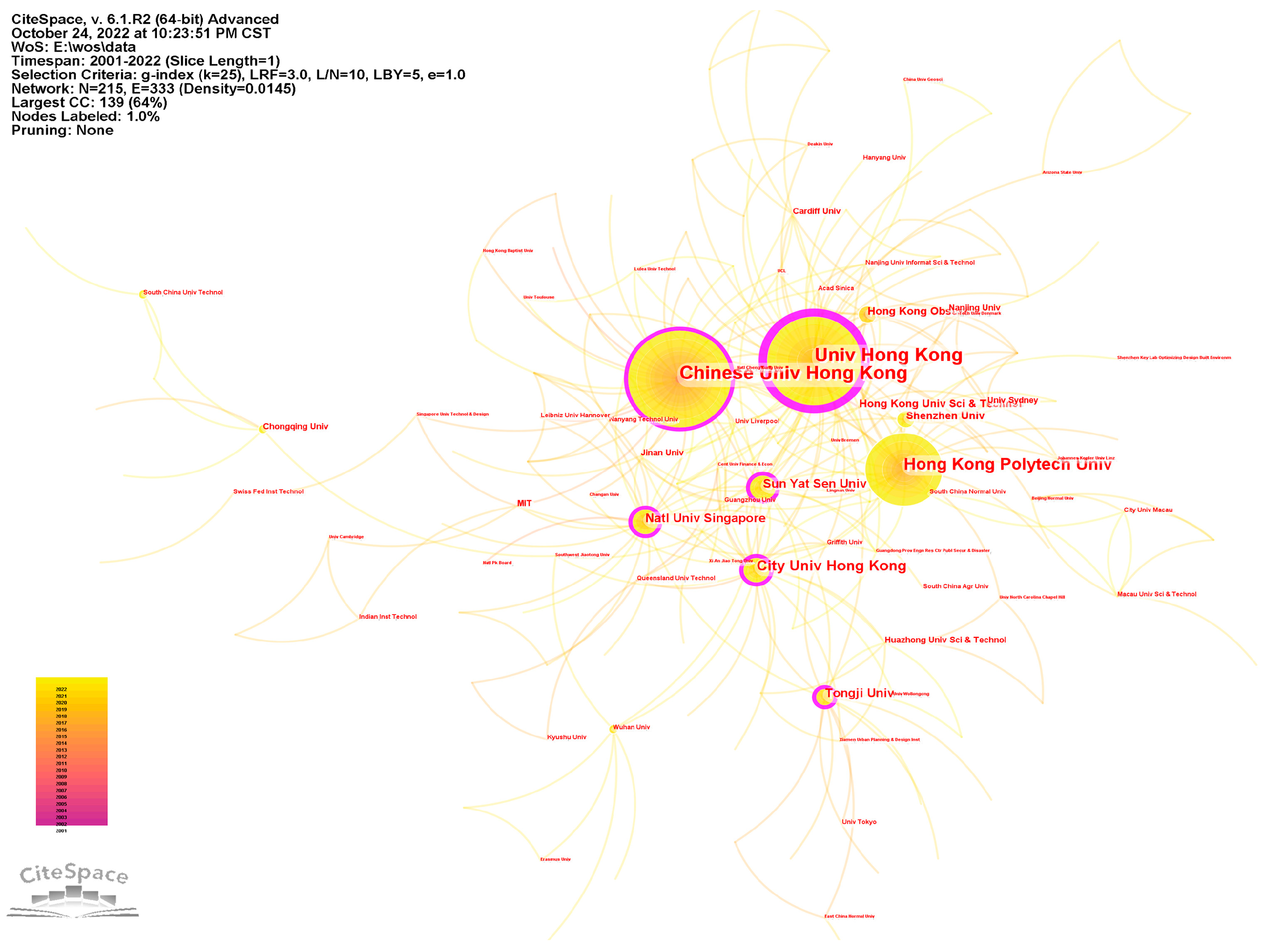
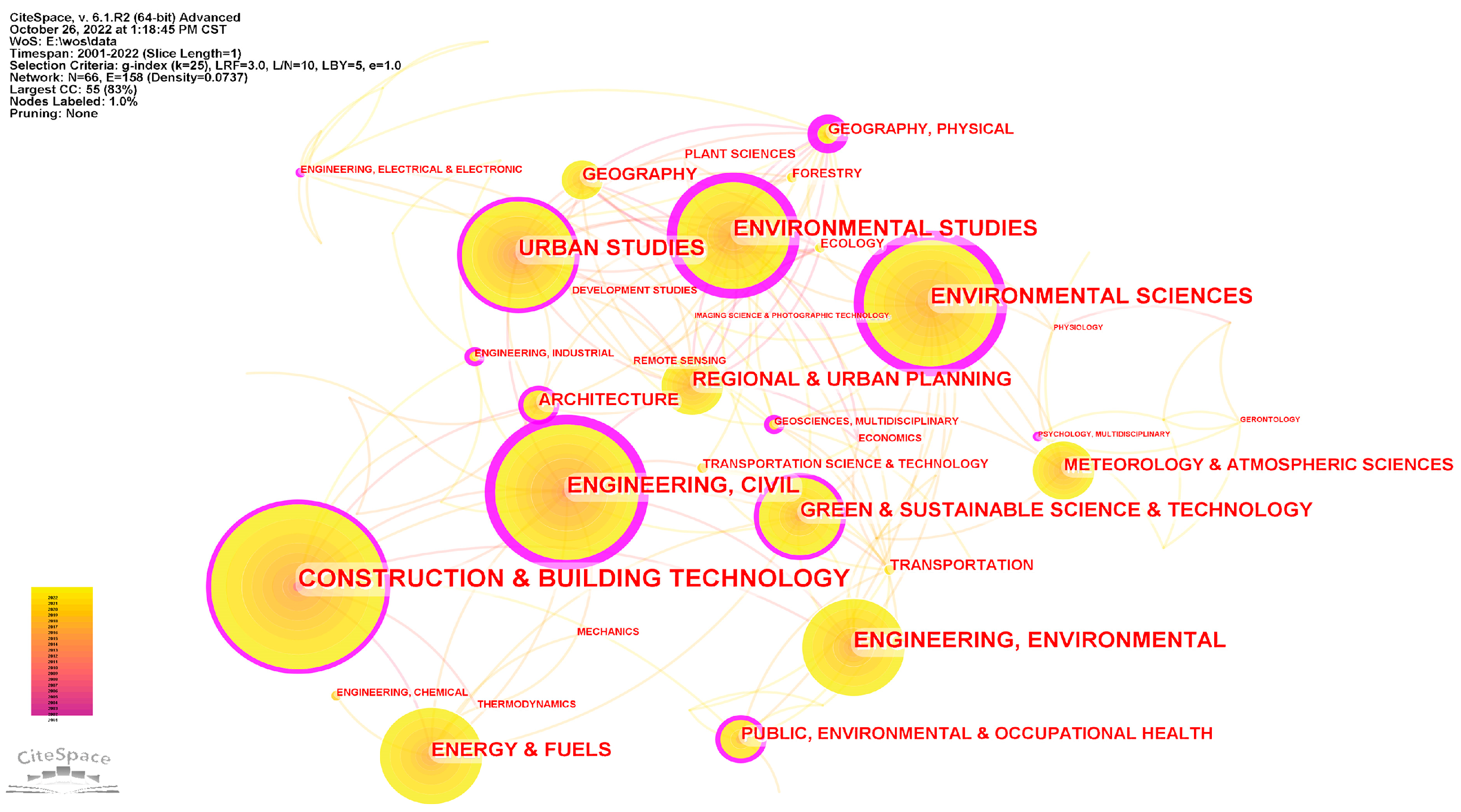
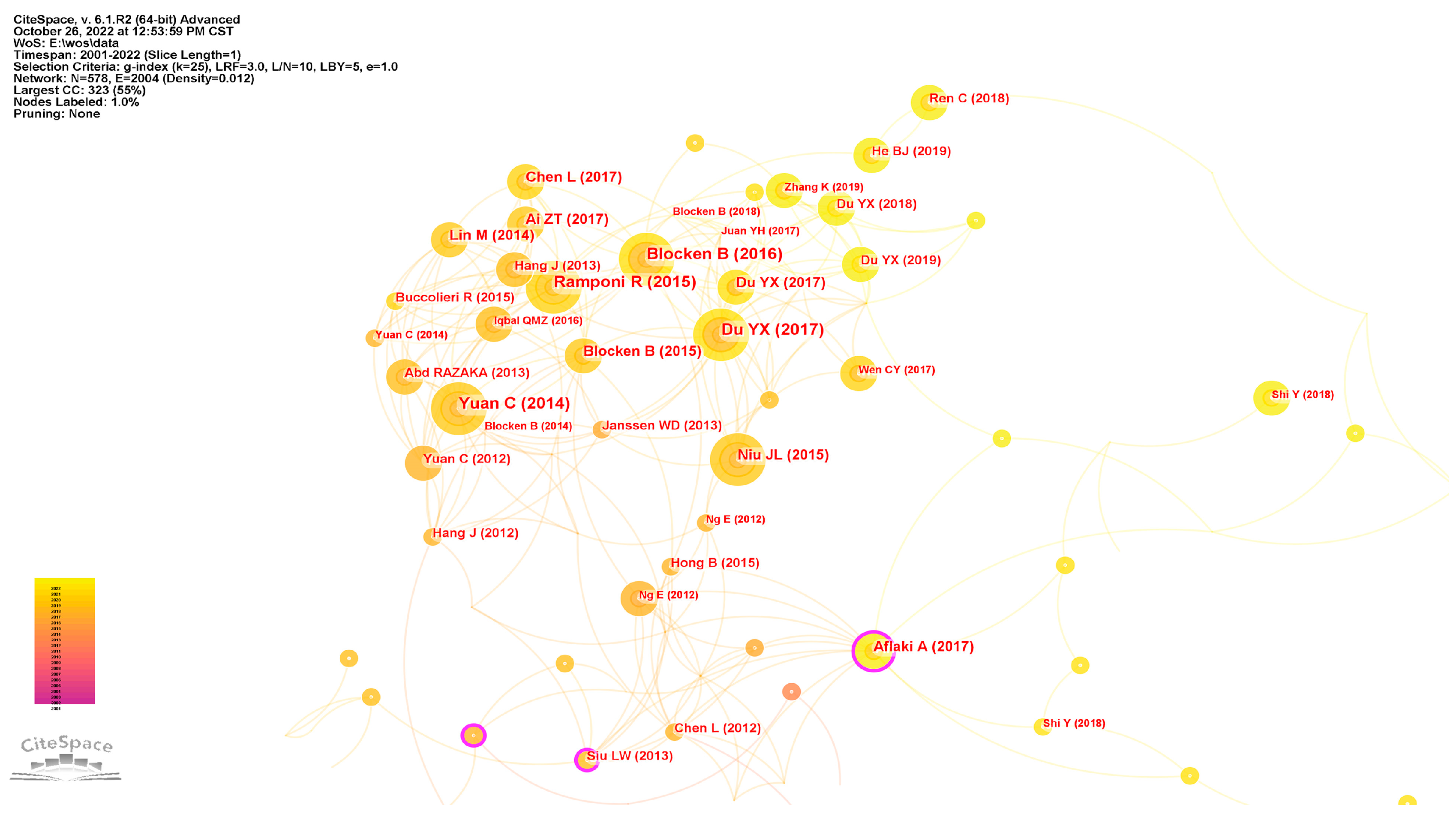

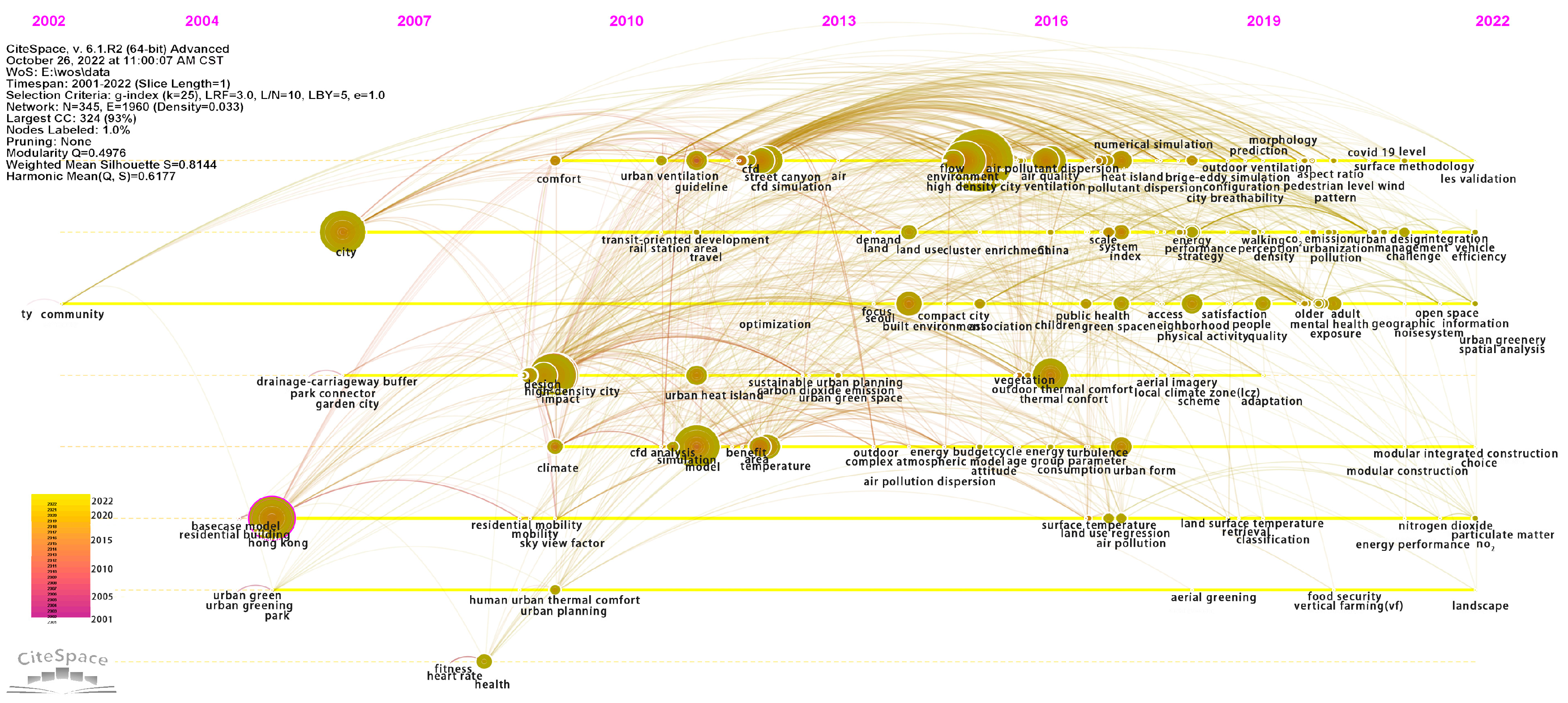
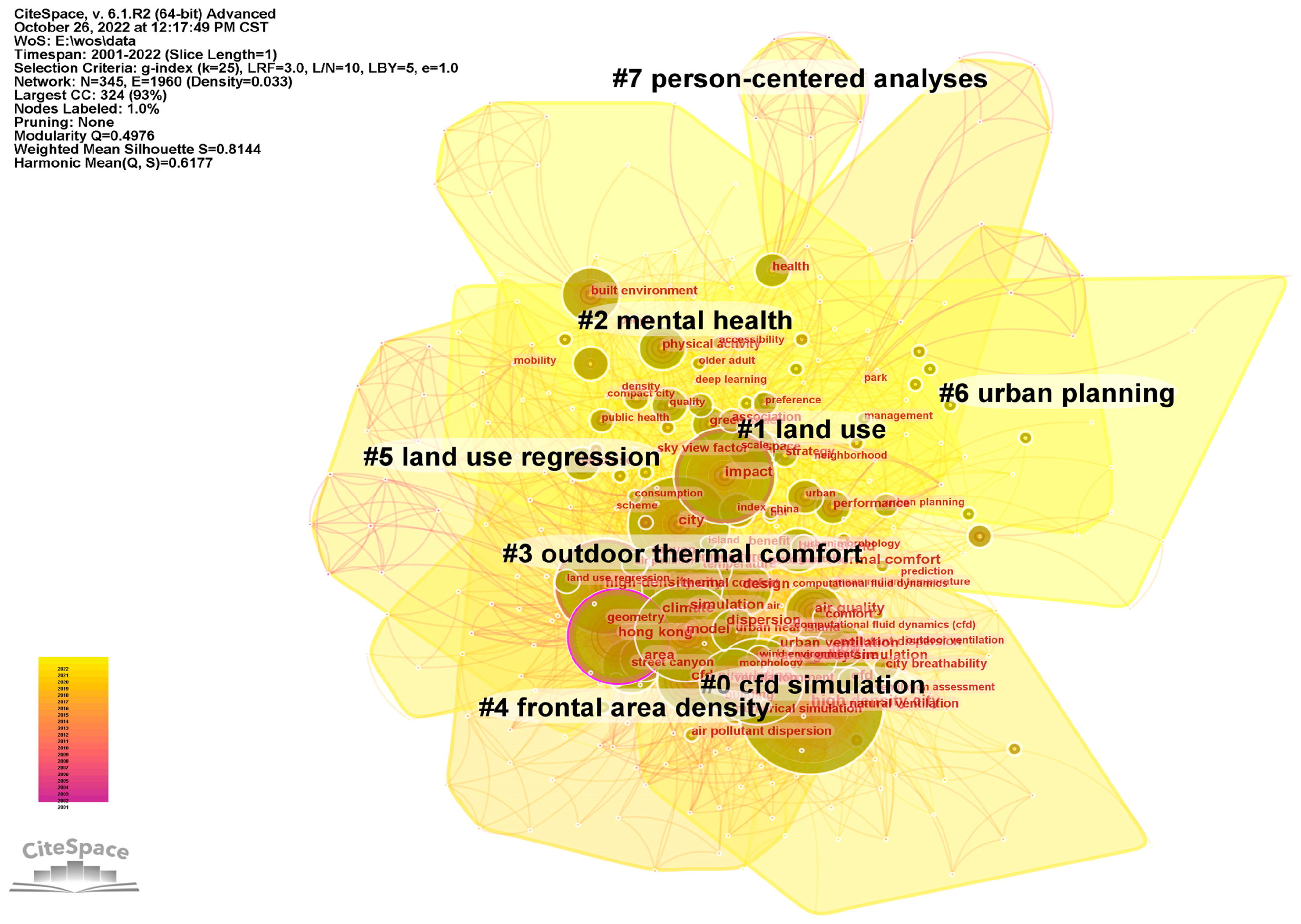
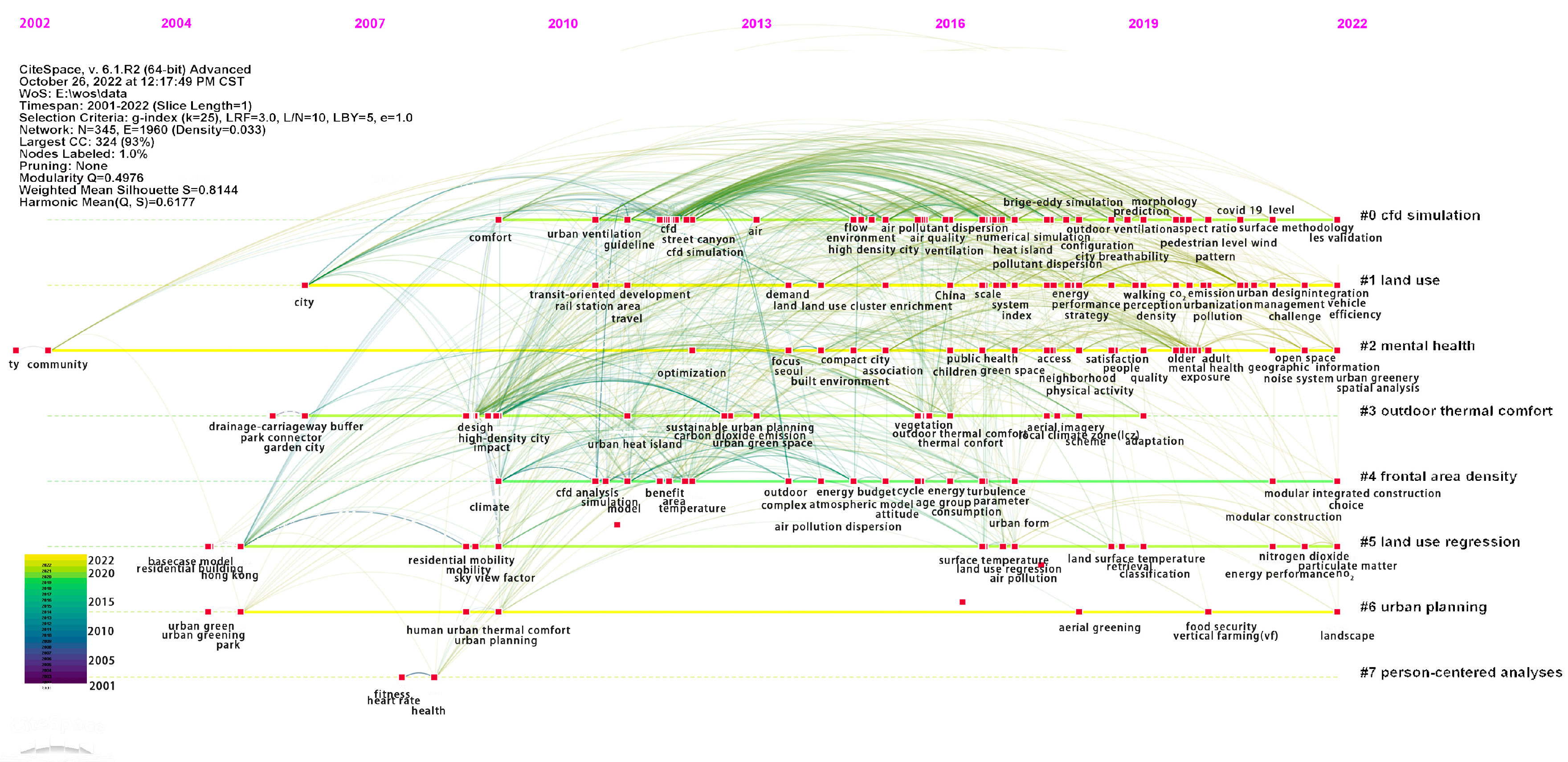

| Publisher | Name | Release Time | Focus |
|---|---|---|---|
| United Nations | The Millennium Declaration | September 2000 | Protection of the typical environment; increased cooperation to reduce the number and impact of natural and artificial disasters |
| United Nations | Special Session of the General Assembly on Habitat: Istanbul + 5 6–8 June 2001, New York | June 2001 | Adequate shelter for all and sustainable human settlement development; sustainable cities |
| World Summit on Sustainable Development | Johannesburg for Sustainable Development | September 2002 | Sustainability; social development to meet the needs of each individual; climate and energy |
| United Nations | New Urban Agenda | October 2016 | Sustainable urban development; cities, human settlements, and sustainable civic development |
| No. | Freq. | Centrality | Cited Journals | ISSN | Country | First Cited Year |
|---|---|---|---|---|---|---|
| 1 | 198 | 0..07 | Building and Environment | 0360-1323 | England | 2005 |
| 2 | 173 | 0.15 | Landscape and Urban Planning | 0169-2046 | The Netherlands | 2006 |
| 3 | 128 | 0.05 | Energy and Buildings | 0378-7788 | Switzerland | 2001 |
| 4 | 122 | 0.11 | Atmospheric Environment | 1352-2310 | England | 2008 |
| 5 | 112 | 0.03 | Science of the Total Environment | 0048-9697 | The Netherlands | 2015 |
| 6 | 107 | 0.02 | Sustainable Cities and Society | 2210-6707 | The Netherlands | 2016 |
| 7 | 94 | 0.07 | Cites | 0264-2751 | England | 2008 |
| 8 | 85 | 0.03 | Journal of Wind Engineering and Industrial Aerodynamics | 0167-6105 | The Netherlands | 2012 |
| 9 | 80 | 0.03 | Sustainability | 2071-1050 | Switzerland | 2009 |
| 10 | 79 | 0.05 | International Journal of Climatology | 0899-8418 | England | 2016 |
| No. | Country | Number of Articles | Centrality | Year of First Publication |
|---|---|---|---|---|
| 1 | China | 270 | 0.73 | 2001 |
| 2 | USA | 33 | 0.1 | 2014 |
| 3 | Singapore | 31 | 0.27 | 2005 |
| 4 | Australia | 29 | 0.12 | 2002 |
| 5 | England | 21 | 0.24 | 2002 |
| 6 | South Korea | 15 | 0 | 2006 |
| 7 | Germany | 14 | 0.18 | 2012 |
| 8 | Japan | 11 | 0.08 | 2009 |
| 9 | France | 6 | 0.08 | 2017 |
| 10 | Wales | 5 | 0.02 | 2018 |
| No. | Publications | Centrality | Year | Author | Country | Main Subject Categories |
|---|---|---|---|---|---|---|
| 1 | 39 | 0.13 | 2008 | Ng, Enoch | China | Construction and Building Technology |
| 2 | 27 | 0.05 | 2013 | Lau, Kevin Ka-lun | China | Construction and Building Technology |
| 3 | 21 | 0.05 | 2011 | Ren, Chao | China | Environmental Sciences and Ecology |
| 4 | 18 | 0.05 | 2016 | Shi, Yuan | China | Environmental Sciences and Ecology |
| 5 | 12 | 0.04 | 2011 | Yuan, Chao | Singapore | Science and Technology |
| 6 | 12 | 0.04 | 2017 | Mak, Cheuk Ming | China | Engineering |
| 7 | 9 | 0.06 | 2011 | Chen, Liang | China | Engineering |
| 8 | 9 | 0.08 | 2017 | Ho, Huang Chak | China | Environmental Sciences and Ecology |
| 9 | 9 | 0.03 | 2020 | Pan, Wei | China | Environmental Sciences and Ecology |
| 10 | 8 | 0.01 | 2015 | Li, Yu Guo | China | Engineering |
| No. | Freq. | Year | Institution |
|---|---|---|---|
| 1 | 84 | 2001 | The University of Hong Kong |
| 2 | 69 | 2008 | The Chinese University of Hong Kong |
| 3 | 42 | 2008 | The Hong Kong Polytechnic University |
| 4 | 23 | 2009 | City University of Hong Kong |
| 5 | 20 | 2005 | National University of Singapore |
| 6 | 17 | 2016 | Tongji University |
| 7 | 16 | 2018 | Sun Yat Sen University |
| 8 | 12 | 2017 | Shenzhen University |
| 9 | 9 | 2011 | Hong Kong University of Science and Technology |
| 10 | 9 | 2017 | Hong Kong Observatory |
| No. | Freq. | Year | WoSCC Categories |
|---|---|---|---|
| 1 | 106 | 2005 | Construction and Building Technology |
| 2 | 85 | 2005 | Civil Engineering |
| 3 | 76 | 2016 | Engineering Sciences |
| 4 | 66 | 2005 | Environmental Studies |
| 5 | 60 | 2005 | Urban Studies |
| 6 | 57 | 2009 | Environmental Engineering |
| 7 | 51 | 2001 | Green and Sustainable Science and Technology |
| 8 | 50 | 2001 | Energy and Fuels |
| 9 | 38 | 2005 | Regional and Urban Planning |
| 10 | 26 | 2005 | Geography |
| No | Title | Times Cited | Publication Year | Research Area |
|---|---|---|---|---|
| 1 | Computational Fluid Dynamics for urban physics: Importance, scales, possibilities, limitations and ten tips and tricks towards accurate and reliable simulations | 484 | 2015 | Construction and Building Technology |
| 2 | CFD simulation of outdoor ventilation of generic urban configurations with different urban densities and equal and unequal street widths | 197 | 2015 | Construction and Building Technology |
| 3 | Pedestrian-level wind conditions around buildings: a review of wind-tunnel and CFD techniques and their accuracy for wind comfort assessment | 185 | 2016 | Construction and Building Technology |
| 4 | Improving air quality in high-density cities by understanding the relationship between air pollutant dispersion and urban morphologies | 183 | 2017 | Construction and Building Technology |
| 5 | Urban heat island mitigation strategies: A state-of-the-art review on Kuala Lumpur, Singapore and Hong Kong | 157 | 2017 | Urban Studies |
| 6 | Building porosity for better urban ventilation in high-density cities—a computational parametric study | 136 | 2012 | Construction and Building Technology |
| 7 | The impacts of building height variations and building packing densities on flow adjustment and city breathability in idealised urban models | 112 | 2017 | Construction and Building Technology |
| 8 | Enhancing urban ventilation performance through the development of precinct ventilation zones: A case study based on the Greater Sydney, Australia | 112 | 2019 | Construction and Building Technology |
| 9 | Quantitative ventilation assessments of idealised urban canopy layers with various urban layouts and the same building packing density | 105 | 2014 | Construction and Building Technology |
| 10 | A new method to assess spatial variations of outdoor thermal comfort: Onsite monitoring results and implications for precinct planning | 103 | 2015 | Construction and Building Technology |
| No. | Freq. | Centrality | Year | Keywords |
|---|---|---|---|---|
| 1 | 72 | 0.09 | 2015 | High-density city |
| 2 | 55 | 0.12 | 2009 | Impact |
| 3 | 53 | 0.10 | 2006 | City |
| 4 | 48 | 0.21 | 2005 | Hong Kong |
| 5 | 45 | 0.09 | 2011 | Model |
| 6 | 41 | 0.04 | 2015 | Environment |
| 7 | 38 | 0.01 | 2016 | Thermal comfort |
| 8 | 37 | 0.09 | 2009 | Design |
| 9 | 30 | 0.05 | 2012 | CFD simulation |
| 10 | 25 | 0.02 | 2012 | Street canyon |
| Start-Up Period (2001–2006) | ||||
| No. | Freq. | Centrality | Year | Keywords |
| 1 | 53 | 0.10 | 2006 | City |
| 2 | 48 | 0.21 | 2005 | Hong Kong |
| 3 | 2 | 0 | 2002 | Attract radius model |
| 4 | 2 | 0 | 2002 | Lightning-strike incidence |
| 5 | 1 | 0 | 2002 | Lightning protection system positioning |
| 6 | 1 | 0 | 2002 | Tall structure |
| 7 | 1 | 0 | 2005 | Green architecture |
| Development Period (2007–2014) | ||||
| No. | Freq. | Centrality | Year | Keywords |
| 1 | 55 | 0.13 | 2009 | Impact |
| 2 | 45 | 0.09 | 2011 | Model |
| 3 | 30 | 0.05 | 2012 | CFD simulation |
| 4 | 25 | 0.02 | 2012 | Street canyon |
| 5 | 23 | 0.08 | 2014 | Built environment |
| 6 | 23 | 0.02 | 2012 | Temperature |
| 7 | 21 | 0.02 | 2011 | urban heat island |
| Accelerated Period (2015–Present) | ||||
| No. | Freq. | Centrality | Year | Keywords |
| 1 | 41 | 0.04 | 2015 | Environment |
| 2 | 38 | 0.01 | 2016 | Thermal comfort |
| 3 | 25 | 0.03 | 2016 | Ventilation |
| 4 | 22 | 0.03 | 2016 | Air quality |
| 5 | 20 | 0.02 | 2018 | Physical activity |
| 6 | 18 | 0.01 | 2016 | Flow |
| 7 | 18 | 0.02 | 2019 | Quality |
| Cluster-ID | Size | Silhouette Value | Year | Label (LLR) |
|---|---|---|---|---|
| #0 | 75 | 0.818 | 2016 | CFD simulation; void ground floor; urban street canyon; water channel experiment; pedestrian-level wind environment|computational fluid dynamics; building porosity; pedestrian level wind comfort; building height; urban morphology |
| #1 | 55 | 0.685 | 2018 | Supply chain resilience; fuzzy synthetic evaluation; supply chain vulnerabilities; industrialised construction; thermal index|urban green space; Google Street View image; pedestrian level greenery; local climate zone; urban morphology |
| #2 | 50 | 0.769 | 2017 | High-density city; public health; nature sound; mood states; green landscape|physical activity; street view images; street greenery; high-density cities; dense urban environment |
| #3 | 48 | 0.825 | 2011 | High-density city; urban performance; humid climate; mitigation strategies; anthropogenic heat|outdoor thermal comfort; high-density cities; local climate zone; subjective thermal perception; microclimatic conditions |
| #4 | 43 | 0.887 | 2014 | High-density city; summer reference year; indoor thermal comfort; cooling energy consumption; building simulation|urban ventilation; block porosity; high density urbanisation; urban geometry; urban heat island |
| #5 | 32 | 0.881 | 2013 | Land-use regression; high-density cities; vertical variation modelling; three-dimensional model; urban heat island|air pollution; urban surface geomorphometry; wind availability; mountainous high-density city; urban heat island |
| #6 | 12 | 0.958 | 2010 | Urban planning; spatial pattern; morphological spatial pattern analysis; urban green spaces; visual characteristics|human perception; human activity density; visual characteristics; resident perceptions; high urban density |
| #7 | 9 | 0.998 | 2008 | Heart rate; comparison; accelerometer; pedometer; validation|willingness-to-pay; Seoul; happiness; urban park; heart rate |
Disclaimer/Publisher’s Note: The statements, opinions and data contained in all publications are solely those of the individual author(s) and contributor(s) and not of MDPI and/or the editor(s). MDPI and/or the editor(s) disclaim responsibility for any injury to people or property resulting from any ideas, methods, instructions or products referred to in the content. |
© 2023 by the authors. Licensee MDPI, Basel, Switzerland. This article is an open access article distributed under the terms and conditions of the Creative Commons Attribution (CC BY) license (https://creativecommons.org/licenses/by/4.0/).
Share and Cite
Yao, M.; Yao, B.; Cenci, J.; Liao, C.; Zhang, J. Visualisation of High-Density City Research Evolution, Trends, and Outlook in the 21st Century. Land 2023, 12, 485. https://doi.org/10.3390/land12020485
Yao M, Yao B, Cenci J, Liao C, Zhang J. Visualisation of High-Density City Research Evolution, Trends, and Outlook in the 21st Century. Land. 2023; 12(2):485. https://doi.org/10.3390/land12020485
Chicago/Turabian StyleYao, Muxia, Bin Yao, Jeremy Cenci, Chenyang Liao, and Jiazhen Zhang. 2023. "Visualisation of High-Density City Research Evolution, Trends, and Outlook in the 21st Century" Land 12, no. 2: 485. https://doi.org/10.3390/land12020485






